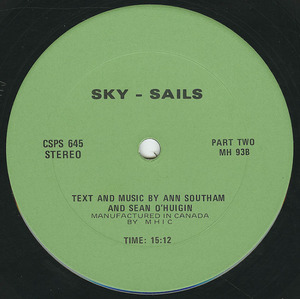Information/Write-up
Ann Southam was born in Winnipeg, Manitoba on February 4, 1937, her father (Kenneth Gordon Southam) was the great-grandson of Canadian newspaper baron William Southam.
At the age of three Southam and her family re-located to Toronto, Ontario, which was to be her home for the rest of her life. She was educated at the exclusive Bishop Strachan School (BSS) for Girls.
1952 marked a watershed year for Ann, her father died, and she also developed an interest in composition, which was nurtured by a summer she spent at the Banff School of Fine Arts (the first of many trips to the School). However, at her mother’s insistence, after graduating high school she briefly pursued secretarial studies at Shaw’s Business School. She dropped out after a year, when she secured a place at the Royal Conservatory of Music.
At the Royal Conservatory Southam was mentored by the progressive Professor Samuel “Sam” Dolin. Dolin introduced Southam to the world of “tape music” (now “electronic composition). During this period, Southam started to study piano with Pierre Souvairan and electronic music with Gustav Ciamaga at the University of Toronto, where she was a student between 1960 and 1963.
In 1966, Southam began teaching electroacoustic composition at the Royal Conservatory of Music. Dolin introduced Southam to dancer and choreographer Patricia Beatty, who introduced Southam to the world of modern dance. Beatty would go on to found the Toronto Dance Theatre. In 1968 Southam became the Theatre’s Composer-in-Residence, beginning a 15 year collaboration over which time Southam wrote at least thirty electronic works for their productions. Her work with the Theatre helped establish her as one of Canada’s leading composers.
In the late 1970s Southam begin collaborating with Music Inter Alia, the brainchild of fellow Banff School alumna Diana McIntosh, on creating mixed media works, such as “Eliptosonics” (1979) and “Light Lines, Sound Lines” (1980).
In the early 1980s Southam’s compositions started to reflect a shift away from electronic to acoustic music. This was inspired by a renewed interest in “the physicality of performing”. For instance in 1981’s “Four in Hand”, written for pianists Jane Blackstone and Ruth Kazdan involves the performers “blasting about the keyboard” (as described in “Musicworks”, Summer 1998).
At the same time she developed an interest in more minimalist composition, inspired by composers such as Terry Riley and Steve Reich. This demonstrated itself in pieces such as “Glass Houses” (1981). “Glass Houses” was important as it also introduced Southam to a longtime professional collaborator, pianist Christina Petrowska-Quilico, who recorded a demo tape of two Southam pieces: “Glass Houses” and “Rivers”.
As one of Canada’s first major women composers, Southam was deeply interested in nurturing new women composers and artists, quietly funding many new initiatives, performances, and projects. She was a founding member, first president (1980-1988), and later honourary president of the Association of Canadian Women Composers (ACWC). Feminist elements have long been noticed in her work, collaborators such as Eve Egoyan and Gayle Young noted that according to Southam “there is a close connection between composing for or playing the piano and other forms of work done by hand, such as weaving, that reflect the nature of traditional women’s work—repetitive, life-sustaining, requiring time and patience…” (“Musicworks”, no. 101).
In the late 1980s and 1990s Southam abandoned electroacustic writing, composing works such as “Throughways” (1988) written for a chamber orchestra, works for stringed instruments such as “Song of the Varied Thrush” (1991) and “Webster’s Spin” (1993). Later she started a long-standing and fruitful collaboration with pianist Eve Egoyan, working together on “Qualities of Consonance” (1998) and the critically acclaimed “Simple Lines of Enquiry” (2008).
In 2008 Southam was diagnosed with lung cancer, dying two years later in 2010 on November 25, 2010 (Eve Egoyan and Christina Petrowska-Quilico performed at her memorial). Shortly before her death, on May 6, 2010 she was inducted into the Order of Canada, her citation read: “For her contributions as one of Canada’s prominent women composers, known for electronic, acoustic and orchestral works, and as a philanthropist and committed volunteer”.






No Comments